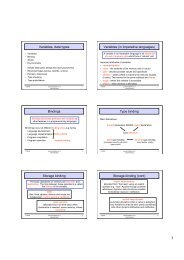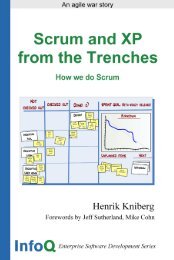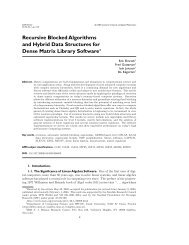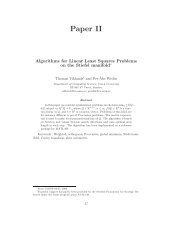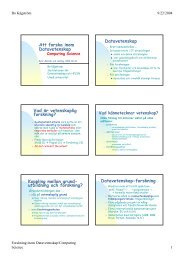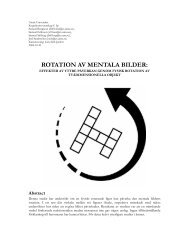Designing a persistent online strategy game - Department of ...
Designing a persistent online strategy game - Department of ...
Designing a persistent online strategy game - Department of ...
You also want an ePaper? Increase the reach of your titles
YUMPU automatically turns print PDFs into web optimized ePapers that Google loves.
40 Chapter 4. Models & methods for evaluating <strong>game</strong>s<br />
playing and comment on their experience. A moderator observes their play and takes<br />
notes, but should try not to influence their play. To find areas where players are stuck<br />
or have problems as little help as possible should be given.<br />
After the session the players are interviewed about their experience. Other methods<br />
that can be used are feedback forms or open ended discussions.<br />
4.8.3 Consumer Playtest<br />
The Consumer Playtest (CP) [14] is a quantitative method which purpose is to identify<br />
<strong>game</strong>play issues with a <strong>game</strong>. The focus is to gather players’ attitudes towards different<br />
aspects <strong>of</strong> a <strong>game</strong>. CP is performed with 25-35 participants in a lab. The first step<br />
is to answer a questionnaire that is designed to ensure that they belong to the target<br />
group <strong>of</strong> the <strong>game</strong>. Step two is to let them play the <strong>game</strong> for a period <strong>of</strong> time, they<br />
are instructed to play it as they would do at home and are also given all material that<br />
they would have if they bought it. In step three players answers a questionnaire about<br />
their experience. The questions can concern aspects such as perceived graphics, sound,<br />
controls, and overall fun. Some questions are <strong>game</strong> specific, such as for example the<br />
puzzle elements in a puzzle <strong>game</strong>.<br />
With a small sample <strong>of</strong> users in evaluation it is hard to generalise their opinions and<br />
experiences to the whole target group. The data gathered there is only representative<br />
for the users in the evaluation. In CP the sample <strong>of</strong> players is large enough to enable<br />
statistical analysis on the data gathered. This allows for the comparison between different<br />
CP sessions. Different <strong>game</strong>s and different version <strong>of</strong> the same <strong>game</strong> can thus<br />
be compared statistically. This encourages iteration when designers can see how the<br />
changes affect players’ opinions and experience <strong>of</strong> a <strong>game</strong>.<br />
4.8.4 Heuristic evaluation<br />
Heuristic evaluation is one <strong>of</strong> the discount methods described by Nielsen [43]. When<br />
using discount methods evaluators sacrifice some degree <strong>of</strong> certainty and statistical significance<br />
in favor <strong>of</strong> a low cost. The argument for using discount methods is that some<br />
usability evaluation is better than none [43]. People do not have to be usability experts<br />
to do a heuristic evaluation; novices can also identify some usability issues. It however<br />
requires some expertise to know how to apply the heuristics so experienced evaluators<br />
usually finds more issues than novices.<br />
In heuristic evaluation one or several experts review the system with the help <strong>of</strong> the<br />
heuristics. Every occurrence where the system violates the heuristics is noted down and<br />
graded. Usually the expert also gives an example <strong>of</strong> a solution to the problem. If there<br />
are several experts it is important that the evaluation is performed separately. This is<br />
to ensure that as many problems as possible are identified. After evaluation the experts<br />
meet to discuss the problems they found before they write a report for the designers<br />
[43].<br />
Games can also benefit from heuristic evaluation. Usability heuristics has been shown<br />
to provide new and useful data in <strong>game</strong> development [34]. But the differences between



